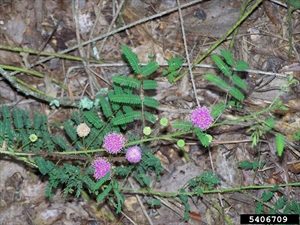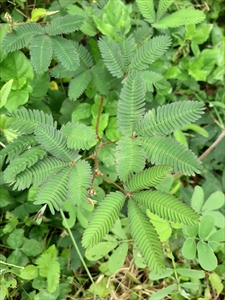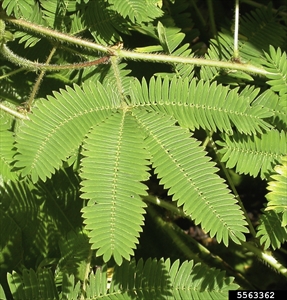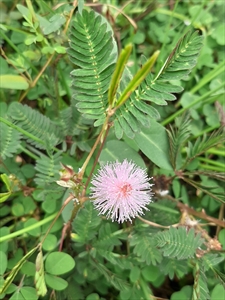- Widespread. Asia, Africa, North, South and Central America, Caribbean, Oceania. In many Pacific islands.
- Thrives in disturbed areas, tolerant, of shade and different soil types, producing abundant seed, invading plantations (bananas, citrus, coconuts, coffee, oil palm, papaya, rubber), pastures, crops, lawns, roadsides, and wasteland. Mimosine causes thyroid problems in cattle. A fire hazard when dead.
- Small prickly shrub, up to 50 cm, creeps. Stems brown to purple, woody, branched, with sharp thorns. Leaves, hairy, alternate along stems, bearing 1-2 pairs leaf-like branches, with paired dark green leaflets. Flower stalks, with thorns, bearing bright purplish-pink, oval, flower clusters, with long stamens giving a fluffy look. Seeds, in long seed pods, splitting into 2-4, 1-seeded segments bearing bristles. Root is long and strong
- Spread: seeds, by animals, clothing; use as ornamental; moved in soil, sand, gravel.
- Biosecurity: high risk of introduction via trade as an ornamental. Among 10 worst weeds in American Samoa, French Polynesia, Guam, Solomon Islands, Tonga. On Global Invasive Species Database of alien invasive species (IUCN, 2020).
- Biocontrol: Little known.
- Cultural control: hand weed (thorns!) or hoe; mulch; vehicle hygiene; prevent overgrazing (adjust stocking rate, forcing cattle to eat young plants).
- Chemical control: in Australia: MCPA + terbutryn; fluroxypyr; dicamba; picloram + triclopyr; hexazinone + diuron. In Fiji, 2,4-D; glyphosate.
Pacific Pests, Pathogens and Weeds - Online edition
Pacific Pests, Pathogens, Weeds & Pesticides
Sensitive plant (464)
Sensitive plant; it is also known as mimosa, common sensitive plant, or touch-me-not.
Mimosa pudica. There are a number of varieties. It is a member of the Fabaceae.
AUTHORS Grahame Jackson, Aradhana Deesh & Mani Mua
Adapted from Common sensitive plant (Mimosa pudica) (2018) Weeds of SE Qld and Northern NSW. Lucidcentral. (https://www.lucidcentral.org/editors-pick-animal-and-plant-identification-keys/key-to-weeds-of-se-qld-and-northern-nsw); and additional information from CABI (2019) Mimosa pudica (sensitive plant). Invasive Species Compendium. (https://www.cabi.org/isc/datasheet/34202); and Waterhouse DF, Norris KR (1987) Mimosa pudica Linnaeus. Biological Control Pacific Prospects. Inkata Press, Melbourne; and from Mimosa pudica (2020) Wikipedia. (https://en.wikipedia.org/wiki/Mimosa_pudica). Photos 1&5 Karan A. Rawlins, University of Georgia, Bugwood.org; Photo 4 Shaun Winterton, Aquarium and Pond Plants of the World, Edition 3, USDA APHIS PPQ, Bugwood.org; Photo 7 Forest and Kim Starr, Starr Environmental, Bugwood.org.
Produced with support from the Australian Centre for International Agricultural Research under project HORT/2016/185: Responding to emerging pest and disease threats to horticulture in the Pacific islands, implemented by the University of Queensland, in association with the Pacific Community and Koronivia Research Station, Ministry of Agriculture, Fiji.











